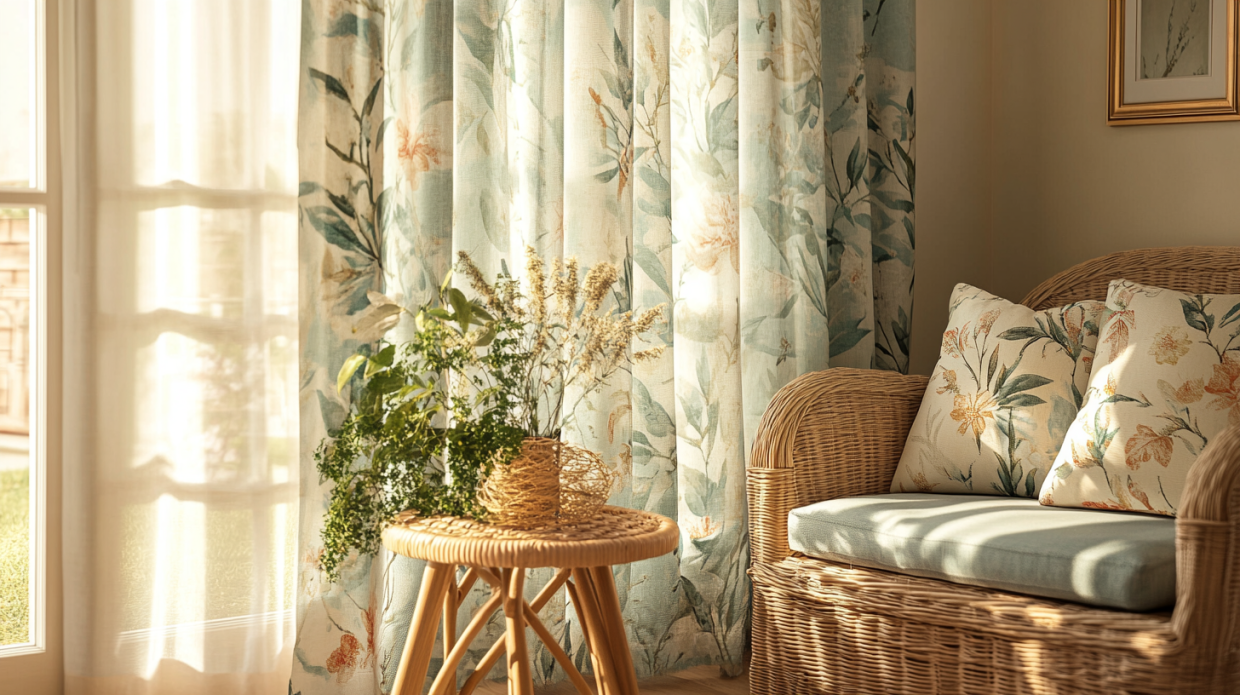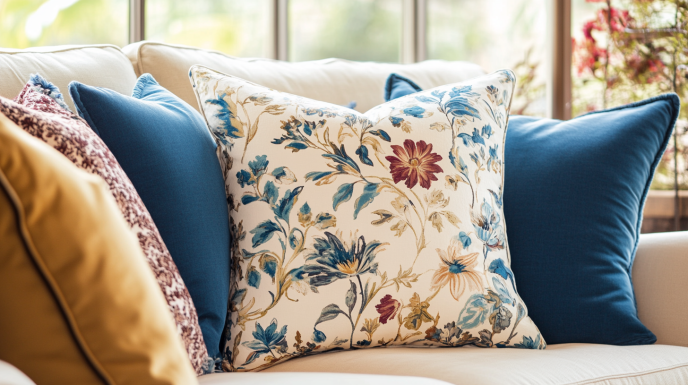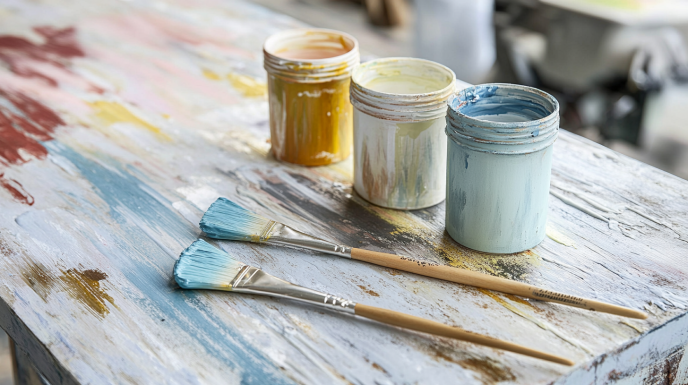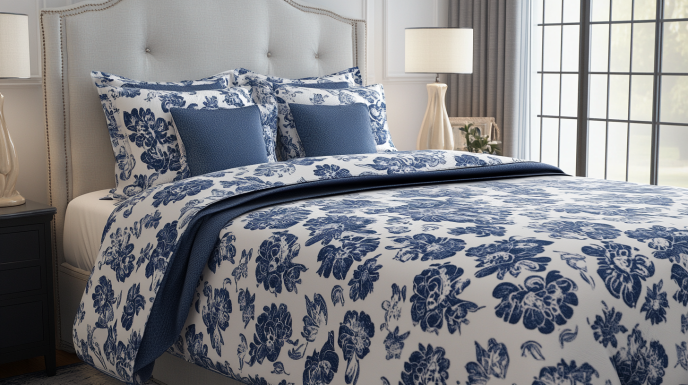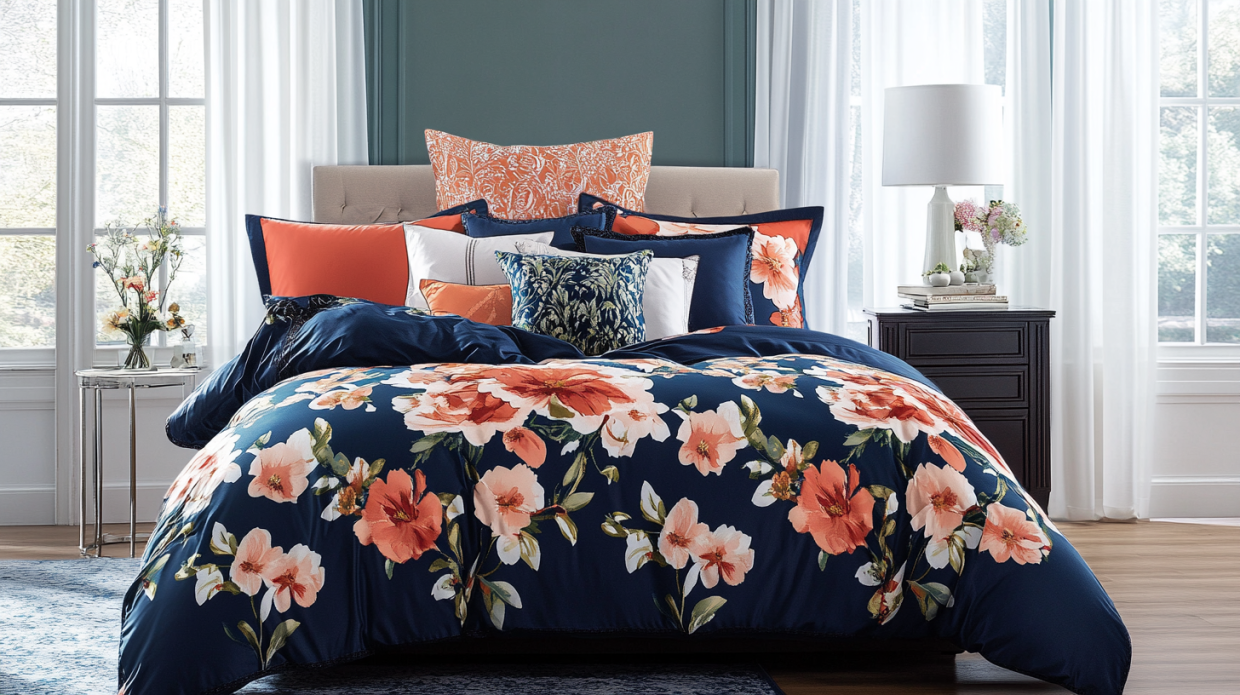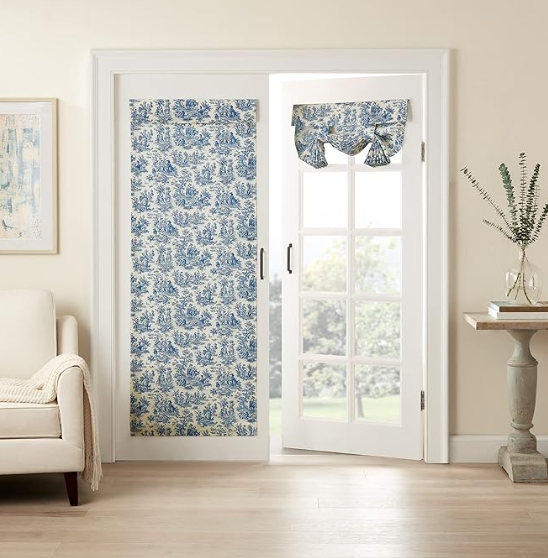
Waverly Charmed Life Classic French Country Curtain for Window of French Door, Glass Door, or Patio Door, Single Panel, 26″ x 68″, Cornflower
- 100% Cotton
- Imported
- STYLISH WINDOW CURTAIN – Add style and function to windows in your bedroom or living room. Panel can be let down for privacy and light control, and ties allow you to keep it open easily. Sold as a single panel, measuring 26” x 68” with hook and loop strips for easy setup, no curtain rod necessary

Waverly Spree Flamingo Flock Room Darkening Thermal Insulated Rod Pocket Curtains for Bedroom, Single Panel, 42″ x 84″, Pink
- Polyester
- PREMIUM QUALITY – Masterly crafted 100% Polyester room darkening curtains. Sold as a single panel (Panel measures 42″ wide and 84″ long).
- LIGHT BLOCKING LEVEL – Waverly Room Darkening curtains blocks out sunlight and harmful UV rays and ensures upmost privacy. Perfect for your living room, bedroom, kids room, nursery and more!
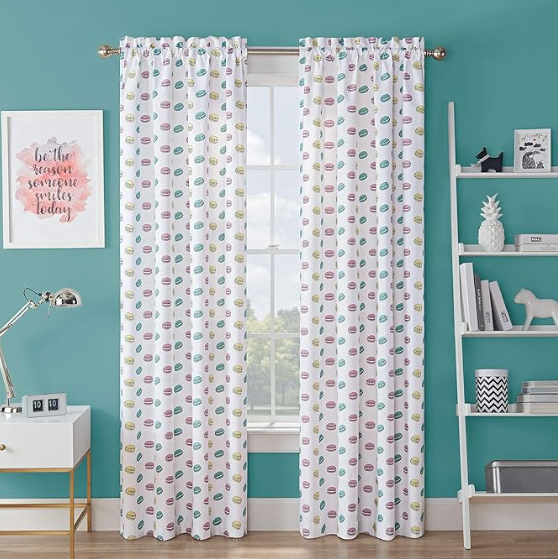
Waverly Life is Sweet Insulated Darkening Single Panel Rod Pocket Window Treatment Living Room, 42″ x 84″, Multi
- Polyester
- PREMIUM QUALITY – Masterly crafted 100% Polyester room darkening curtains. Sold as a single panel (Panel measures 42″ wide and 84″ long).
- LIGHT BLOCKING LEVEL – Waverly Room Darkening curtains blocks out sunlight and harmful UV rays and ensures upmost privacy. Perfect for your living room, bedroom, kids room, nursery and more!

Waverly Imperial Dress Jacobean Floral Rod Pocket Back Tab Curtains for Windows in Bedroom, Kitchen, or Living Room, Single Panel, 42″ x 84″, Porcelain
- 100% Cotton
- STYLISH WINDOW CURTAIN – Add style and function to windows in your bedroom or living room. Panel can be let down for privacy and light control, and ties allow you to keep it open easily. Sold as a single panel, measuring 42” x 84” with a rod pocket and back tab that fit up to a 2.5″ rod
Elevating Home Decor Through Fabric and Design Since 1923
Throughout the rich tapestry of home design history, few names have maintained their reputation for excellence quite like Waverly. As a homeowner constantly in search of that perfect balance between functionality and style, I’ve spent countless hours researching window treatments that truly deliver on their promises. Today, I’m sharing everything you need to know about one of America’s most beloved fabric and home decor brands.
Waverly curtains aren’t just window coverings—they’re statement pieces that transform ordinary rooms into extraordinary spaces. This comprehensive guide will walk you through everything from the brand’s storied heritage to practical tips for selection, installation, and care. Whether you’re a longtime Waverly enthusiast or considering your first purchase, this detailed exploration will equip you with the knowledge to make informed decisions that elevate your home’s aesthetic appeal.
The Waverly Legacy: What Sets These Curtains Apart
Waverly’s journey began in 1923, establishing itself as a premier American fabric house with a distinctive design philosophy that continues to resonate with homeowners today. The brand’s curtains have earned their reputation through a consistent commitment to quality craftsmanship and timeless patterns that somehow manage to feel both classic and contemporary.
What truly distinguishes Waverly curtains is their meticulous attention to pattern development. Unlike mass-produced alternatives that prioritize quantity over quality, Waverly designs are created by skilled artists who understand the subtle interplay between color, texture, and scale. Each pattern tells a story—whether it’s the botanical precision of their floral prints or the architectural inspiration behind their geometric patterns.
The brand’s signature aesthetic combines traditional elements with fresh interpretations, creating window treatments that feel both familiar and novel. This balance makes Waverly curtains particularly versatile, capable of complementing diverse interior styles from traditional to transitional to selectively modern spaces.
Materials used in Waverly curtains reflect this commitment to quality. Premium cotton and cotton blends form the foundation of many collections, offering natural drape and excellent durability. For more luxurious applications, you’ll find sumptuous linen blends and jacquard weaves that add textural interest and sophisticated dimension to any room.
Shopping Made Simple: Where to Purchase Waverly Curtains
Finding authentic Waverly curtains has become significantly easier in the digital age. While the brand once relied primarily on specialty retailers and fabric shops, today’s consumers enjoy multiple convenient purchasing channels.
Major online retailers like Wayfair, Amazon, and Bed Bath & Beyond maintain extensive Waverly curtain collections, often providing detailed photographs and customer reviews that prove invaluable during the selection process. These platforms frequently offer competitive pricing and seasonal promotions that make Waverly’s premium products more accessible.
For those who prefer the personalized experience of in-store shopping, home improvement centers like Lowe’s and department stores such as JCPenney typically stock popular Waverly patterns. This approach allows you to assess fabric quality and color accuracy firsthand—an important consideration given that digital displays can sometimes misrepresent subtle color variations.
The brand’s official website serves as another reliable resource, showcasing the complete lineup of current collections alongside design inspiration and detailed product specifications. While Waverly.com may not always offer direct purchasing, it connects consumers with authorized retailers and provides valuable background information on specific collections.
Discount retailers like HomeGoods, Tuesday Morning, and Overstock occasionally feature Waverly curtains at significantly reduced prices. These outlets typically carry discontinued patterns or seasonal collections, presenting excellent opportunities for budget-conscious decorators willing to be flexible about specific designs.
Cost Considerations: What to Expect When Investing in Waverly Curtains
Waverly curtains occupy a mid-to-high price range within the window treatment market, reflecting their quality materials and design integrity. Standard panel pairs typically range from $50 to $150, depending on size, fabric composition, and pattern complexity.
More elaborate styles featuring special details like embroidery, lined construction, or specialty weaves can command higher prices, sometimes reaching $200-$300 per panel pair. These premium options often incorporate additional functional benefits such as room-darkening or thermal insulation properties.
When evaluating cost, it’s important to consider the longevity Waverly curtains provide. Their durable construction and timeless aesthetic frequently outlast less expensive alternatives that may require replacement after just a few years. This extended lifespan ultimately improves their value proposition despite the higher initial investment.
Seasonal sales present strategic opportunities to acquire Waverly curtains at reduced prices. Major retailers typically discount home textiles during January white sales, end-of-season clearances, and major holiday weekends. Subscribing to retailer newsletters can alert you to these promotional events, allowing you to time purchases advantageously.
Custom Waverly curtains represent the highest price tier, with costs varying significantly based on fabric selection, window dimensions, and specialty features. While custom options deliver precise measurements and tailored details, ready-made curtains often provide comparable quality at more accessible price points for standard window sizes.
Style Spectrum: Exploring Waverly Curtain Designs
Waverly’s design portfolio spans an impressive range of aesthetic directions, unified by the brand’s commitment to artful execution and enduring appeal. Understanding these stylistic categories can help narrow your selection process based on your home’s architectural character and your personal preferences.
Traditional patterns remain among Waverly’s most recognizable offerings, with floral designs like “Norfolk Rose” and “Garden Glory” capturing the brand’s heritage aesthetic. These designs often incorporate detailed botanical renderings with rich color development, creating window treatments that serve as focal points in formal living spaces and master bedrooms.
For transitional interiors that bridge classic and contemporary elements, Waverly offers sophisticated geometric patterns and updated damasks. Collections like “Trend Spotter” and “Momentum” deliver visual interest through scale variation and thoughtful color combinations, complementing diverse furniture styles without overwhelming the space.
Coastal and country-inspired designs represent another significant category within the Waverly repertoire. Nautical motifs, pastoral scenes, and cheerful gingham patterns create casual, inviting atmospheres perfect for vacation homes, kitchens, and family-oriented spaces. These designs often feature cleaner backgrounds with distinctive motifs that contribute character without visual heaviness.
For minimalist spaces requiring subtler window treatments, Waverly’s textural solids and small-scale patterns provide sophisticated solutions. These understated options emphasize fabric quality and construction details rather than bold pattern statements, harmonizing with contemporary furnishings while maintaining the brand’s quality standards.
The most popular Waverly curtain patterns have achieved near-iconic status among interior designers. Perennial favorites include the romantic “Fleuretta,” the sophisticated “Prance,” and the versatile “Lovely Lattice”—designs that have demonstrated remarkable staying power across changing design trends.
Technical Specifications: Understanding Waverly Curtain Features
Beyond aesthetics, Waverly curtains offer various functional specifications that affect their performance in different settings. Understanding these technical aspects ensures your selection meets practical requirements while delivering desired visual effects.
Regarding light control, Waverly provides options across the filtering spectrum. Standard unlined curtains typically offer moderate light filtering, softening natural illumination while maintaining daytime brightness. For rooms requiring more significant light reduction, lined options provide enhanced privacy and moderate room darkening without complete blackout functionality.
True blackout Waverly curtains incorporate special backing or interlinings designed to block approximately 90-99% of incoming light. These specialized options prove particularly valuable in bedrooms, media rooms, and spaces where light control directly impacts functionality. Popular blackout collections include “Sound Asleep” and “Night & Day,” which combine decorative exteriors with highly effective light-blocking technology.
Size availability spans standardized dimensions suitable for most residential applications. Typical panel widths range from 42″ to 54″, with lengths including 63″, 84″, and 95″ to accommodate various window heights. For sliding doors and dramatic window treatments, 108″ and 120″ lengths provide extended coverage without custom ordering.
Thermal efficiency varies across collections, with specialized insulating options available for energy-conscious homeowners. These thermal curtains typically feature multi-layer construction that helps regulate room temperature by reducing heat transfer through window glass. While not as technically advanced as dedicated thermal brands, Waverly’s insulating curtains offer a balanced combination of decorative appeal and practical energy benefits.
Header styles include rod pocket, back tab, and grommet designs, each creating different visual effects and hanging characteristics. Traditional rod pocket headers create gentle gathers for a classic appearance, while back tabs produce a more tailored, contemporary look with defined pleats. Grommet-top curtains slide effortlessly on decorative rods, making them practical choices for frequently adjusted window treatments.
Manufacturing Origins: Where Waverly Curtains Are Produced
The production geography of Waverly curtains reflects the complex reality of modern textile manufacturing. While Waverly began as an American company with domestic production facilities, today’s global supply chain has diversified their manufacturing footprint considerably.
Currently, most Waverly curtains are manufactured in overseas facilities located primarily in China, India, and Pakistan. These production centers leverage specialized textile expertise and established infrastructure while adhering to Waverly’s quality standards and design specifications. Factory partners undergo regular auditing to ensure consistent product quality and ethical manufacturing practices.
Fabric design and pattern development still maintain significant American influence, with design studios in New York overseeing the creative direction that defines the brand’s signature aesthetic. This creative control ensures that despite offshore production, Waverly curtains maintain their distinctive character and design integrity.
For consumers concerned about environmental impact and labor practices, Waverly has implemented monitoring systems to address ethical manufacturing considerations. While not all collections carry formal sustainability certifications, certain lines incorporate eco-friendly materials and production methods that reduce environmental footprint without compromising quality.
The brand’s corporate ownership has evolved over time, with Waverly now operating as part of F. Schumacher & Co., a historic American design house with its own rich heritage in premium fabrics and wallcoverings. This partnership has maintained Waverly’s design DNA while expanding its market reach and manufacturing capabilities.
Proper Care: Maintaining Your Waverly Curtains
Appropriate maintenance significantly extends the lifespan of Waverly curtains, preserving their appearance and functional properties for years. Care requirements vary by fabric composition and construction details, with most collections featuring specific guidelines on attached tags or packaging.
For routine maintenance, regular vacuuming with a brush attachment prevents dust accumulation that can degrade fabric over time. This gentle cleaning method proves particularly important for curtains in high-traffic areas or homes with pets, where airborne particles consistently settle on vertical surfaces.
When more thorough cleaning becomes necessary, washing instructions depend heavily on specific fabric composition. Many cotton and cotton-blend Waverly curtains are machine washable on gentle cycles with mild detergent. However, this convenience isn’t universal—specialty fabrics often require professional cleaning or alternative methods to prevent damage.
Machine-washable Waverly curtains should be laundered according to specific label instructions to maintain their beauty and structural integrity. Typically, this involves cold water, gentle detergent, and delicate cycles that minimize agitation. After washing, promptly removing curtains from the machine helps prevent deep wrinkles, while proper reshaping before hanging facilitates natural drying without distortion.
For curtains requiring dry cleaning, professional services familiar with fine fabrics yield the best results. When selecting a dry cleaner, inquire about their experience with decorative textiles and specify any concerns about pattern preservation or special finishes that require particular attention.
Between cleanings, spot treatment addresses localized stains without subjecting entire panels to unnecessary processing. Blotting (never rubbing) fresh spills with clean, absorbent cloths removes most substances before they set permanently. For persistent stains, testing cleaning solutions on inconspicuous areas prevents unintended damage to visible portions.
Ironing or steaming restores Waverly curtains to their optimal appearance after cleaning or storage. Most cotton and blend fabrics respond well to medium-heat ironing on reverse sides, while steam treatments prove particularly effective for delicate materials that cannot withstand direct iron contact.
Installation Insights: Hanging Waverly Curtains Correctly
Proper installation maximizes both the aesthetic impact and functional performance of Waverly curtains. Following established hanging techniques ensures optimal drape, proportion, and light control while protecting your investment from unnecessary strain.
Before beginning installation, thorough measurement proves essential. Window width determines appropriate panel quantities and rod length, while height measurements influence both rod placement and ideal curtain length. For most applications, extending rods 3-6 inches beyond window frames on each side creates visual balance while maximizing light blockage when curtains are closed.
Rod height significantly affects spatial perception, with higher placements creating an illusion of increased ceiling height. The general design guideline recommends positioning rods approximately 4-6 inches above window frames, though this distance may increase to 8-12 inches in rooms with taller ceilings to enhance vertical proportion.
For proper fullness, Waverly curtains should measure approximately 2-2.5 times your window’s width when combined. This ratio ensures elegant draping with sufficient fabric to create dimensional folds when curtains are closed. Insufficient fullness results in flat, stretched appearances that diminish the fabric’s natural movement and light-filtering capabilities.
Different header styles require specific hanging techniques. Rod pocket curtains should be carefully gathered along their entire width before sliding onto rods, preventing uneven distribution that can strain fabric over time. Back tab styles benefit from systematic tab placement that creates consistent pleating, while grommet headers naturally create uniform spacing when properly centered on rods.
For layered treatments combining Waverly curtains with sheers or other window coverings, double rod systems provide practical functionality. These installations require careful planning to ensure appropriate depth for unobstructed movement, typically requiring wall brackets with 3-5 inch projection to accommodate multiple fabric layers.
Customization Options: Personalizing Your Waverly Experience
While ready-made Waverly curtains offer exceptional quality and design diversity, some situations benefit from customized solutions that address specific requirements. Understanding available customization channels helps homeowners balance personalization with practical considerations.
The most accessible customization approach involves adapting ready-made panels through simple modifications. Professional or DIY hemming adjusts standard lengths to accommodate non-standard window heights, while side hems can be adjusted for slight width variations. These modest alterations maintain original design integrity while improving fit for specific applications.
For substantial customization, workrooms specializing in window treatments can transform Waverly fabric (purchased by the yard) into completely bespoke curtains. This approach accommodates unusual window dimensions, specialty heading styles, and detailed design specifications beyond standard offerings. While significantly more expensive than ready-made options, custom Waverly curtains deliver precise proportions and tailored details for discriminating homeowners.
Fabric-by-the-yard purchases enable the most extensive customization possibilities, allowing coordinated treatments throughout rooms or homes. Beyond curtains, Waverly fabrics can be applied to complementary elements including valances, pillow covers, and upholstered accents that create cohesive design statements across multiple surfaces.
Some retailers offer semi-custom programs that modify standard Waverly patterns with limited personalization options. These middle-ground solutions typically adjust dimensions, linings, and header styles while maintaining standardized patterns and materials. While not offering unlimited flexibility, these programs provide reasonable customization at costs below fully bespoke treatments.
When considering customization, timeline expectations require adjustment. Unlike immediate availability of ready-made options, custom Waverly treatments typically require 3-8 weeks for completion depending on workroom capacity, fabric availability, and technical complexity. This extended timeline necessitates advance planning, particularly for new construction or renovation projects with specific completion deadlines.
Design Integration: Selecting the Perfect Waverly Curtains
Choosing appropriate Waverly curtains involves balancing aesthetic preferences with practical considerations specific to each space. This decision-making process benefits from systematic evaluation of room requirements and design objectives.
Room function fundamentally influences curtain selection. Private spaces like bedrooms typically benefit from heavier fabrics and light-controlling properties that enhance sleep quality, while kitchens and bathrooms require materials resistant to moisture and easy to maintain. Living areas often prioritize decorative impact and flexibility, balancing privacy needs with natural light appreciation.
Existing color schemes provide crucial context for curtain selection. Waverly’s diverse palette offers options that either complement or purposefully contrast with established colors. For cohesive integration, identifying secondary or accent colors within rooms provides natural connection points for curtain patterns that feel intentionally coordinated rather than arbitrarily selected.
Scale consideration prevents visual competition between curtains and other patterned elements. Rooms already featuring bold wallpaper, distinctive upholstery, or statement rugs generally benefit from more subdued curtain patterns that provide complementary texture without pattern overwhelm. Conversely, spaces with neutral foundations can support more expressive Waverly patterns as focal design elements.
Architectural style offers another important selection filter. Traditional homes naturally accommodate Waverly’s classic floral and damask patterns, while mid-century structures might better support geometric designs or simplified botanicals that reference period-appropriate motifs. Contemporary architecture often pairs successfully with Waverly’s more abstracted patterns or textural solids that add warmth without historical reference.
Light management objectives significantly influence appropriate selections. South-facing rooms with abundant natural light might require more substantial fabrics with light-reducing properties, while north-facing spaces often benefit from lighter-weight options that maximize available illumination. East and west exposures present variable conditions that might suggest layered solutions combining sheers with more substantial Waverly panels for adjustable light control.
Modern Applications: Waverly Curtains in Contemporary Settings
While Waverly maintains strong associations with traditional decor, their evolving collections increasingly address contemporary design sensibilities. Understanding how these classic textiles integrate into modern interiors reveals their remarkable adaptability.
The current design landscape’s appreciation for eclecticism creates natural opportunities for Waverly curtains in otherwise contemporary spaces. Modern rooms featuring clean lines and minimal ornamentation often benefit from the textural interest and measured pattern that Waverly brings, creating balanced compositions that avoid sterile minimalism without sacrificing sophisticated restraint.
Scale manipulation represents one strategy for incorporating Waverly patterns into modern contexts. Oversized interpretations of traditional motifs create contemporary impact while maintaining design heritage, while reduced-scale patterns read as textural elements rather than period-specific decorations. Collections like “Modern Essence” and “Contemporary Classics” specifically address this intersection of traditional pattern language with updated scale relationships.
Color contemporization offers another pathway for integrating Waverly into modern interiors. Traditional patterns rendered in current color palettes—particularly those featuring unexpected combinations or single-color interpretations—maintain pattern integrity while signaling design currency. Monochromatic Waverly patterns prove particularly effective in contemporary settings, adding subtle dimension without historical weight.
Architectural contrast creates compelling juxtapositions between structural modernism and textile traditionalism. Contemporary spaces characterized by clean geometry and architectural restraint often benefit from the humanizing influence of Waverly’s handcrafted aesthetic, creating balanced environments that honor both innovation and tradition.
Digital printing technology has expanded Waverly’s design possibilities, enabling photorealistic renderings and complex gradients previously unachievable through conventional textile production. These technical advancements support more contemporary pattern expressions while maintaining the brand’s commitment to artistic quality and visual sophistication.
Sustainability Considerations: Eco-Friendly Waverly Options
As environmental consciousness grows among consumers, Waverly has gradually expanded their eco-friendly offerings without compromising their design standards. Understanding these sustainable options helps environmentally concerned homeowners make aligned purchasing decisions.
Material selection represents the most significant factor in Waverly’s sustainability profile. Certain collections now incorporate organic cotton, recycled polyester, and other environmentally preferable fibers that reduce chemical inputs and resource consumption. These materials maintain expected performance standards while reducing environmental impact compared to conventional alternatives.
Production methods have similarly evolved to address environmental concerns. Water-based printing processes, reduced-impact dyes, and energy-efficient manufacturing increasingly characterize Waverly’s production approach, though implementation varies across different collections and manufacturing facilities.
Packaging modifications reflect another dimension of the brand’s sustainability journey. Reduced plastic use, recyclable materials, and more compact packaging designs minimize waste associated with product distribution and storage. While not directly affecting curtain performance, these considerations increasingly influence environmentally motivated purchasing decisions.
Durability itself represents an often-overlooked sustainability factor. Waverly’s commitment to quality construction and timeless design creates products with extended useful lifespans, reducing replacement frequency and associated resource consumption. This longevity-based sustainability differentiates quality brands from disposable alternatives despite sometimes higher initial resource inputs.
For consumers prioritizing environmental considerations, specific Waverly collections like “Natural Elements” and “Pure Living” emphasize eco-friendly materials and production methods. These targeted lines incorporate organic fibers, sustainable production processes, and reduced-impact finishing techniques while maintaining the brand’s signature aesthetic quality.
Alternatives and Comparisons: Understanding the Competitive Landscape
While Waverly maintains a distinctive market position, several comparable brands offer alternative approaches to decorative window treatments. Understanding these options provides useful context for evaluating Waverly’s relative strengths and limitations.
Direct competitors include heritage brands like Robert Allen, Duralee, and Schumacher, which similarly emphasize design integrity and material quality. These alternatives typically occupy similar or higher price points, often with more extensive customization options but less retail accessibility than Waverly’s widely distributed collections.
Mass-market alternatives from retailers like Pottery Barn, Crate & Barrel, and West Elm offer design-conscious options at comparable price points. These competitors typically feature more trend-responsive patterns with shorter design lifecycles, contrasting with Waverly’s emphasis on enduring aesthetics. Construction quality varies significantly within these alternatives, requiring careful evaluation against Waverly’s consistent standards.
Budget-oriented options from retailers like Target, Wayfair’s house brands, and HomeGoods provide similar visual concepts at substantially lower prices. These alternatives typically achieve cost reduction through simplified construction, lighter-weight fabrics, and pattern approximation rather than original design development. While initially attractive financially, these options generally offer reduced longevity and less refined pattern execution.
Custom workroom alternatives represent the premium alternative to Waverly’s ready-made offerings. These bespoke options provide unlimited customization and material selection but at significantly higher price points and with extended production timelines. For standard applications, Waverly’s ready-made quality often delivers comparable performance at more accessible costs.
When evaluating alternatives, consider how different brands balance key factors including design originality, material quality, construction standards, price accessibility, and long-term performance. Waverly’s distinctive value proposition centers on balancing these elements to deliver design-conscious quality at accessible price points through standardized sizing and widespread retail distribution.
Conclusion: The Enduring Appeal of Waverly Curtains
Through nearly a century of design evolution, Waverly curtains have maintained their relevance by balancing tradition with adaptation. Their enduring popularity stems from this nuanced approach to changing tastes—preserving core design values while thoughtfully incorporating contemporary influences.
For today’s homeowners, Waverly curtains offer a distinctive combination of artistic integrity, material quality, and practical functionality rarely found at comparable price points. Their diverse collections address varied aesthetic preferences while maintaining consistent construction standards that support long-term performance.
Whether you’re furnishing a traditional home with classic patterns, seeking transitional designs for eclectic spaces, or exploring how heritage brands can complement contemporary interiors, Waverly’s extensive portfolio offers relevant solutions. Their commitment to design excellence continues to resonate with discerning consumers who recognize the significant impact thoughtfully selected window treatments have on overall interior character.
As you consider your own window treatment options, remember that Waverly curtains represent more than mere functional objects—they embody a design philosophy that respects pattern heritage while embracing careful innovation. This balanced approach has sustained their relevance through decades of changing trends, making them worthy of consideration for today’s mindful home decorators.

